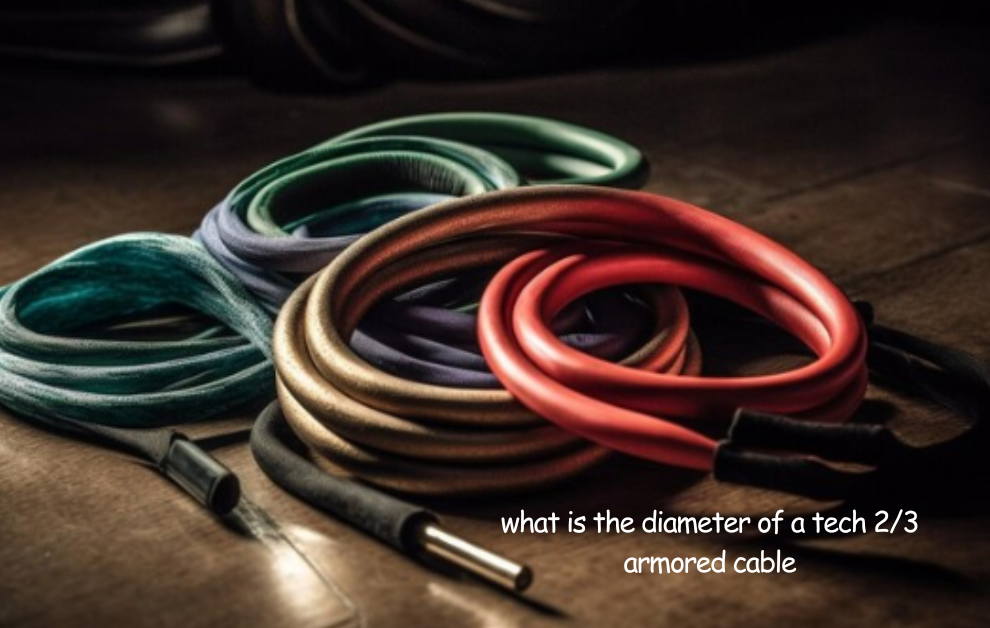What is the Diameter of a Tech 2/3 Armored Cable?

When it comes to electrical installations, knowing the exact dimensions of the cables you’re working with is crucial. For industrial or heavy-duty electrical applications, Tech 2/3 armored cables are a go-to option offering robust protection and versatility. However, understanding what is the diameter of a Tech 2/3 armored cable can be complex given the variety of factors involved. This guide will break down all the essentials from construction and types to measurement techniques and specific use cases.
Understanding Tech Armored Cables
What Are Tech Armored Cables?
Tech armored cables are a specific type of durable cable designed for environments requiring extra protection. Unlike standard cables which can be vulnerable to mechanical wear extreme temperatures or exposure to chemicals armored cables are built with a robust layer that safeguards the internal wiring. This type of cable is commonly used in commercial, industrial and hazardous environments where reliability and durability are paramount.
Tech cables are classified based on their construction and intended use. Tech 2 and Tech 3 cables which we’re focusing on here are among the most popular variations.
Why “Tech” Armored Cables?
The name “Tech” signifies the technical and structural advantages these cables offer. Tech 2 and Tech 3 armored cables are distinct from other armored cables due to their high resistance to physical damage and environmental stress. They are engineered to withstand challenging conditions which makes them a preferred choice in applications where both safety and longevity are priorities.
Structure of Tech 2/3 Armored Cable
Understanding the anatomy of a Tech 2/3 armored cable can clarify why its diameter can vary. Here’s a look at the layers that contribute to its construction:
| Layer | Material | Purpose |
|---|---|---|
| Outer Jacket | PVC or Polyethylene | Provides environmental protection |
| Armor Layer | Steel or Aluminum | Offers mechanical protection |
| Inner Jacket | PVC or Nylon | Secondary insulation, adds additional safety |
| Insulation | Rubber or Polyethylene | Prevents electrical leakage |
| Conductors | Copper or Aluminum | Carries electrical current |
Protective Qualities
Each of these layers contributes to the overall diameter of the cable and serves a specific purpose. For instance, the armor layer (made of steel or aluminum) adds considerable thickness and durability protecting the cable from external damage. The outer jacket typically resists environmental factors like moisture, sunlight and chemicals. This multi-layer structure makes Tech 2/3 armored cables not only sturdy but also safe for various applications from underground to hazardous industrial areas.
Typical Uses
Due to their durability, Tech 2/3 armored cables are commonly used in the following scenarios:
- Industrial Sites: In heavy-duty machinery and equipment that require strong uninterrupted power.
- Underground and Outdoor Applications: Tech cables excel in outdoor settings where exposure to the elements could damage unarmored cables.
- Hazardous Environments: Factories or locations dealing with chemicals, heat or heavy wear use armored cables for their resilience.
Also Read About Toshiba Qosmio X70 Tech
Why Knowing the Cable Diameter Matters
For any project involving armored cables understanding the diameter of a Tech 2/3 armored cable is crucial. Here’s why:
Conduit Sizing and Installation Space
The diameter directly affects the size of conduits needed to house the cable. Oversized or undersized conduits can lead to safety risks installation issues and added costs. When cables are run in tight spaces knowing the diameter ensures there’s enough room for secure installation.
Safety and Compliance
National electrical codes and standards often specify the diameter and conduit sizing for specific installations. Failing to adhere to these standards can lead to safety issues, regulatory fines or liability concerns. Ensuring the correct diameter helps maintain compliance with safety standards.
Determining the Diameter of Tech 2/3 Armored Cable
Calculating the exact diameter of a Tech 2/3 armored cable involves a few key factors. The cable’s design, insulation materials and armoring all play a part in determining its final diameter.
Factors That Affect Diameter
Material Thickness: Different materials like copper, aluminum and insulation layers vary in thickness.
Armor Type: Steel or aluminum armor can influence the overall size.
Insulation Type: The thickness and type of insulation also impact the cable’s diameter.
Common Sizes and Measurements
While the exact dimensions may vary based on the manufacturer and the specific application, here are some common diameter ranges for Tech 2/3 armored cables:
| Cable Gauge | Approximate Diameter (inches) |
|---|---|
| 14 AWG | 0.50 – 0.55 |
| 12 AWG | 0.60 – 0.65 |
| 10 AWG | 0.70 – 0.75 |
| 8 AWG | 0.85 – 0.90 |
| 6 AWG | 1.05 – 1.10 |
| 4 AWG | 1.25 – 1.30 |
| 2 AWG | 1.45 – 1.50 |
| 1/0 AWG | 1.70 – 1.75 |
| 2/0 AWG | 1.95 – 2.00 |
These measurements provide a general idea of common sizes but may vary slightly depending on the manufacturer or custom specifications.
How to Measure the Diameter
If you need to measure the diameter of a Tech 2/3 armored cable yourself, follow these steps:
- Gather the Right Tools: Use a caliper for the most accurate measurements.
- Take Multiple Measurements: Measure at different points along the cable’s circumference to account for any variations.
- Calculate the Average Diameter: Use the average of all measurements for an accurate final diameter.
Pro Tip: When measuring the diameter of a Tech 2/3 armored cable always double-check with the manufacturer’s specs as slight variations may exist based on the specific build and materials.
Standard Diameter Ranges for Tech 2/3 Armored Cables
Typical Diameter Sizes by Gauge
Below is a reference table for the typical diameters of Tech 2/3 armored cables by gauge. These are not exact figures but are general industry standards:
| Gauge Size | Diameter Range (inches) | Common Applications |
|---|---|---|
| 14 AWG | 0.50 – 0.55 | Indoor wiring, low-power equipment |
| 10 AWG | 0.70 – 0.75 | Outdoor wiring, residential settings |
| 6 AWG | 1.05 – 1.10 | Heavy-duty equipment, commercial use |
| 2 AWG | 1.45 – 1.50 | Industrial machinery |
| 1/0 AWG | 1.70 – 1.75 | High-voltage, industrial setups |
Considerations for Different Applications
For indoor installations, smaller diameters may suffice especially for low-voltage applications. Outdoor and underground installations. On the other hand often require thicker more durable cables that can withstand greater wear and tear. Always consult with a professional or reference technical guides when choosing a cable for specific applications.
Practical Applications and Scenarios
Industrial Use
In a factory setting, Tech 2/3 armored cables often serve in heavy-duty power supply applications. They withstand the wear and tear of machinery, foot traffic and even occasional impacts.
Residential Use
While Tech 2/3 armored cables aren’t as common in homes, they may be used in specific areas like outdoor lighting or garages, where durability is a concern. When used in these settings, the diameter must be carefully considered to fit within conduits and meet residential codes.
Outdoor and Underground Installations
For outdoor settings, cables must withstand elements like moisture temperature fluctuations and sometimes pressure from earth cover. The larger diameters and sturdy construction of Tech 2/3 armored cables make them ideal for underground installations.
Tips for Selecting the Right Tech 2/3 Cable Diameter
When choosing a Tech 2/3 cable, here’s a quick checklist to ensure you select the appropriate diameter for your needs:
Environment: Consider if the cable will be installed indoors, outdoors or underground.
Voltage Requirements: Higher voltage often requires larger diameters for safety.
Length of Run: Long cable runs may need a larger diameter to reduce voltage drop.
Local Codes and Standards: Ensure compliance with local electrical codes.
Common Mistakes to Avoid
Using the Wrong Diameter: Undersized cables can overheat and lead to dangerous conditions.
Ignoring Conduit Sizing: Ensure the diameter allows for easy installation within conduits.
Skipping Professional Consultation: For complex projects, consulting with an electrician or engineer can save time and costs.
Expert Insight: “Selecting the wrong diameter can have costly consequences. Always account for the specific needs of your installation environment as well as local regulations.” – John Doe, Electrical Engineer
Conclusion
The diameter of a Tech 2/3 armored cable is a critical factor in ensuring a safe and efficient installation. With their robust structure and wide-ranging applications, these cables provide the durability and protection needed for challenging environments. By understanding the cable’s anatomy measuring the diameter accurately and selecting the right size for your application, you can ensure a reliable code-compliant installation.




